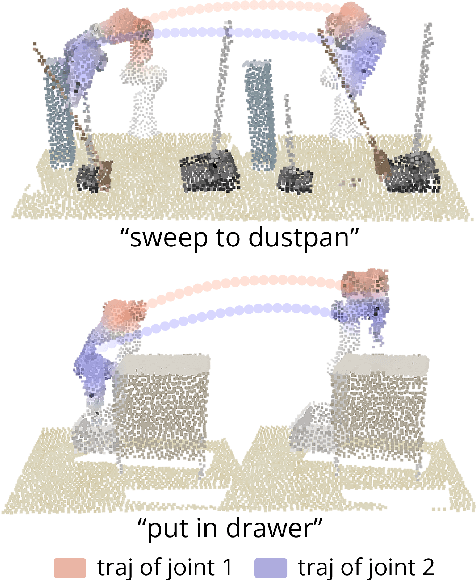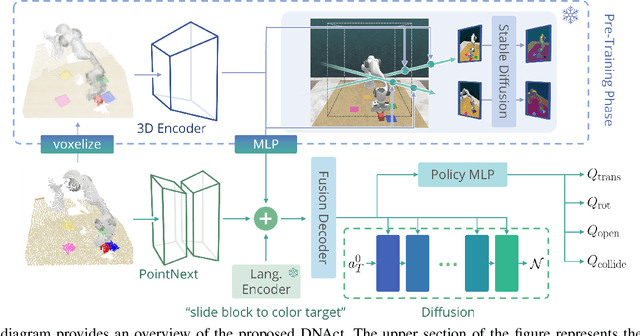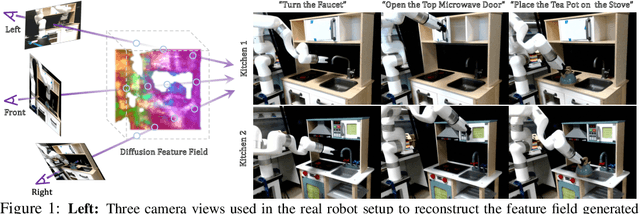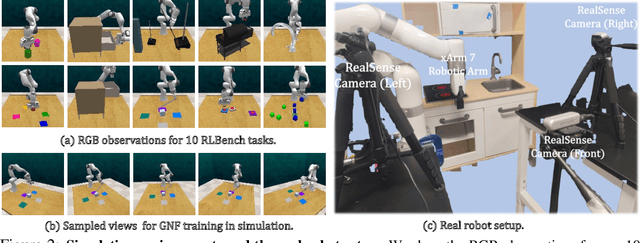Yueh-Hua Wu
ThinkAct: Vision-Language-Action Reasoning via Reinforced Visual Latent Planning
Jul 22, 2025Abstract:Vision-language-action (VLA) reasoning tasks require agents to interpret multimodal instructions, perform long-horizon planning, and act adaptively in dynamic environments. Existing approaches typically train VLA models in an end-to-end fashion, directly mapping inputs to actions without explicit reasoning, which hinders their ability to plan over multiple steps or adapt to complex task variations. In this paper, we propose ThinkAct, a dual-system framework that bridges high-level reasoning with low-level action execution via reinforced visual latent planning. ThinkAct trains a multimodal LLM to generate embodied reasoning plans guided by reinforcing action-aligned visual rewards based on goal completion and trajectory consistency. These reasoning plans are compressed into a visual plan latent that conditions a downstream action model for robust action execution on target environments. Extensive experiments on embodied reasoning and robot manipulation benchmarks demonstrate that ThinkAct enables few-shot adaptation, long-horizon planning, and self-correction behaviors in complex embodied AI tasks.
GenRecal: Generation after Recalibration from Large to Small Vision-Language Models
Jun 18, 2025Abstract:Recent advancements in vision-language models (VLMs) have leveraged large language models (LLMs) to achieve performance on par with closed-source systems like GPT-4V. However, deploying these models in real-world scenarios, particularly on resource-constrained devices, remains challenging due to their substantial computational demands. This has spurred interest in distilling knowledge from large VLMs into smaller, more efficient counterparts. A key challenge arises here from the diversity of VLM architectures, which are built on different LLMs and employ varying token types-differing in vocabulary size, token splits, and token index ordering. To address this challenge of limitation to a specific VLM type, we present Generation after Recalibration (GenRecal), a novel, general-purpose distillation framework for VLMs. GenRecal incorporates a Recalibrator that aligns and adapts feature representations between heterogeneous VLMs, enabling effective knowledge transfer across different types of VLMs. Through extensive experiments on multiple challenging benchmarks, we demonstrate that GenRecal significantly improves baseline performances, eventually outperforming large-scale open- and closed-source VLMs.
Plan2Align: Predictive Planning Based Test-Time Preference Alignment in Paragraph-Level Machine Translation
Feb 28, 2025Abstract:Machine Translation (MT) has been predominantly designed for sentence-level translation using transformer-based architectures. While next-token prediction based Large Language Models (LLMs) demonstrate strong capabilities in long-text translation, non-extensive language models often suffer from omissions and semantic inconsistencies when processing paragraphs. Existing preference alignment methods improve sentence-level translation but fail to ensure coherence over extended contexts due to the myopic nature of next-token generation. We introduce Plan2Align, a test-time alignment framework that treats translation as a predictive planning problem, adapting Model Predictive Control to iteratively refine translation outputs. Experiments on WMT24 Discourse-Level Literary Translation show that Plan2Align significantly improves paragraph-level translation, achieving performance surpassing or on par with the existing training-time and test-time alignment methods on LLaMA-3.1 8B.
VLsI: Verbalized Layers-to-Interactions from Large to Small Vision Language Models
Dec 02, 2024



Abstract:The recent surge in high-quality visual instruction tuning samples from closed-source vision-language models (VLMs) such as GPT-4V has accelerated the release of open-source VLMs across various model sizes. However, scaling VLMs to improve performance using larger models brings significant computational challenges, especially for deployment on resource-constrained devices like mobile platforms and robots. To address this, we propose VLsI: Verbalized Layers-to-Interactions, a new VLM family in 2B and 7B model sizes, which prioritizes efficiency without compromising accuracy. VLsI leverages a unique, layer-wise distillation process, introducing intermediate "verbalizers" that map features from each layer to natural language space, allowing smaller VLMs to flexibly align with the reasoning processes of larger VLMs. This approach mitigates the training instability often encountered in output imitation and goes beyond typical final-layer tuning by aligning the small VLMs' layer-wise progression with that of the large ones. We validate VLsI across ten challenging vision-language benchmarks, achieving notable performance gains (11.0% for 2B and 17.4% for 7B) over GPT-4V without the need for model scaling, merging, or architectural changes.
DNAct: Diffusion Guided Multi-Task 3D Policy Learning
Mar 08, 2024



Abstract:This paper presents DNAct, a language-conditioned multi-task policy framework that integrates neural rendering pre-training and diffusion training to enforce multi-modality learning in action sequence spaces. To learn a generalizable multi-task policy with few demonstrations, the pre-training phase of DNAct leverages neural rendering to distill 2D semantic features from foundation models such as Stable Diffusion to a 3D space, which provides a comprehensive semantic understanding regarding the scene. Consequently, it allows various applications to challenging robotic tasks requiring rich 3D semantics and accurate geometry. Furthermore, we introduce a novel approach utilizing diffusion training to learn a vision and language feature that encapsulates the inherent multi-modality in the multi-task demonstrations. By reconstructing the action sequences from different tasks via the diffusion process, the model is capable of distinguishing different modalities and thus improving the robustness and the generalizability of the learned representation. DNAct significantly surpasses SOTA NeRF-based multi-task manipulation approaches with over 30% improvement in success rate. Project website: dnact.github.io.
Open X-Embodiment: Robotic Learning Datasets and RT-X Models
Oct 17, 2023



Abstract:Large, high-capacity models trained on diverse datasets have shown remarkable successes on efficiently tackling downstream applications. In domains from NLP to Computer Vision, this has led to a consolidation of pretrained models, with general pretrained backbones serving as a starting point for many applications. Can such a consolidation happen in robotics? Conventionally, robotic learning methods train a separate model for every application, every robot, and even every environment. Can we instead train generalist X-robot policy that can be adapted efficiently to new robots, tasks, and environments? In this paper, we provide datasets in standardized data formats and models to make it possible to explore this possibility in the context of robotic manipulation, alongside experimental results that provide an example of effective X-robot policies. We assemble a dataset from 22 different robots collected through a collaboration between 21 institutions, demonstrating 527 skills (160266 tasks). We show that a high-capacity model trained on this data, which we call RT-X, exhibits positive transfer and improves the capabilities of multiple robots by leveraging experience from other platforms. More details can be found on the project website $\href{https://robotics-transformer-x.github.io}{\text{robotics-transformer-x.github.io}}$.
GNFactor: Multi-Task Real Robot Learning with Generalizable Neural Feature Fields
Sep 01, 2023



Abstract:It is a long-standing problem in robotics to develop agents capable of executing diverse manipulation tasks from visual observations in unstructured real-world environments. To achieve this goal, the robot needs to have a comprehensive understanding of the 3D structure and semantics of the scene. In this work, we present $\textbf{GNFactor}$, a visual behavior cloning agent for multi-task robotic manipulation with $\textbf{G}$eneralizable $\textbf{N}$eural feature $\textbf{F}$ields. GNFactor jointly optimizes a generalizable neural field (GNF) as a reconstruction module and a Perceiver Transformer as a decision-making module, leveraging a shared deep 3D voxel representation. To incorporate semantics in 3D, the reconstruction module utilizes a vision-language foundation model ($\textit{e.g.}$, Stable Diffusion) to distill rich semantic information into the deep 3D voxel. We evaluate GNFactor on 3 real robot tasks and perform detailed ablations on 10 RLBench tasks with a limited number of demonstrations. We observe a substantial improvement of GNFactor over current state-of-the-art methods in seen and unseen tasks, demonstrating the strong generalization ability of GNFactor. Our project website is https://yanjieze.com/GNFactor/ .
Elastic Decision Transformer
Jul 07, 2023Abstract:This paper introduces Elastic Decision Transformer (EDT), a significant advancement over the existing Decision Transformer (DT) and its variants. Although DT purports to generate an optimal trajectory, empirical evidence suggests it struggles with trajectory stitching, a process involving the generation of an optimal or near-optimal trajectory from the best parts of a set of sub-optimal trajectories. The proposed EDT differentiates itself by facilitating trajectory stitching during action inference at test time, achieved by adjusting the history length maintained in DT. Further, the EDT optimizes the trajectory by retaining a longer history when the previous trajectory is optimal and a shorter one when it is sub-optimal, enabling it to "stitch" with a more optimal trajectory. Extensive experimentation demonstrates EDT's ability to bridge the performance gap between DT-based and Q Learning-based approaches. In particular, the EDT outperforms Q Learning-based methods in a multi-task regime on the D4RL locomotion benchmark and Atari games. Videos are available at: https://kristery.github.io/edt/
Learning Generalizable Dexterous Manipulation from Human Grasp Affordance
Apr 05, 2022



Abstract:Dexterous manipulation with a multi-finger hand is one of the most challenging problems in robotics. While recent progress in imitation learning has largely improved the sample efficiency compared to Reinforcement Learning, the learned policy can hardly generalize to manipulate novel objects, given limited expert demonstrations. In this paper, we propose to learn dexterous manipulation using large-scale demonstrations with diverse 3D objects in a category, which are generated from a human grasp affordance model. This generalizes the policy to novel object instances within the same category. To train the policy, we propose a novel imitation learning objective jointly with a geometric representation learning objective using our demonstrations. By experimenting with relocating diverse objects in simulation, we show that our approach outperforms baselines with a large margin when manipulating novel objects. We also ablate the importance on 3D object representation learning for manipulation. We include videos, code, and additional information on the project website - https://kristery.github.io/ILAD/ .
DexMV: Imitation Learning for Dexterous Manipulation from Human Videos
Aug 27, 2021



Abstract:While we have made significant progress on understanding hand-object interactions in computer vision, it is still very challenging for robots to perform complex dexterous manipulation. In this paper, we propose a new platform and pipeline, DexMV (Dexterous Manipulation from Videos), for imitation learning to bridge the gap between computer vision and robot learning. We design a platform with: (i) a simulation system for complex dexterous manipulation tasks with a multi-finger robot hand and (ii) a computer vision system to record large-scale demonstrations of a human hand conducting the same tasks. In our new pipeline, we extract 3D hand and object poses from the videos, and convert them to robot demonstrations via motion retargeting. We then apply and compare multiple imitation learning algorithms with the demonstrations. We show that the demonstrations can indeed improve robot learning by a large margin and solve the complex tasks which reinforcement learning alone cannot solve. Project page with video: https://yzqin.github.io/dexmv
 Add to Chrome
Add to Chrome Add to Firefox
Add to Firefox Add to Edge
Add to Edge